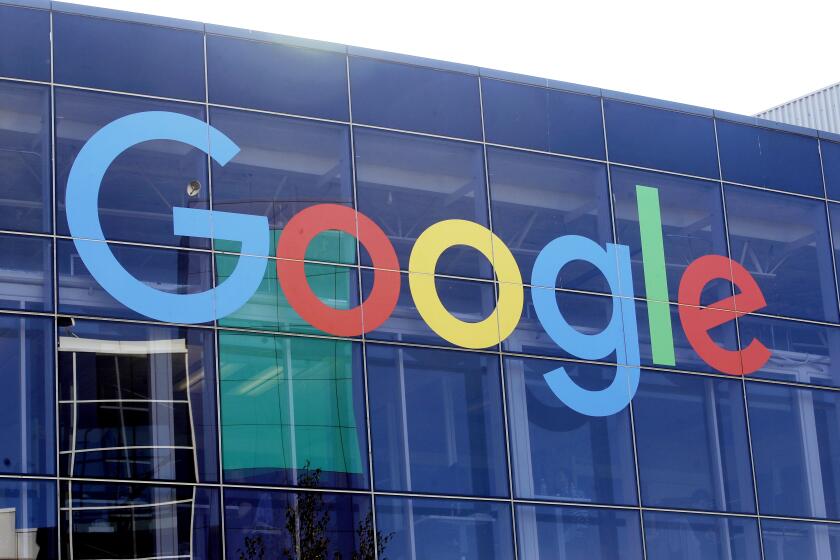Dow Flies Past the 5,500 Mark; Yields Decline
- Share via
The Dow Jones industrial average scored yet another milestone Thursday, breezing through the 5,500 level for the first time, as investors continued to snap up safe blue-chip stocks.
“It’s the absence of a pullback that’s driving people around the bend,” said William LeFevre of Ehrenkrantz King Nussbaum. “People kept holding back thinking the market was too high at 4,000, then 4,500 and then 5,000.”
The Dow surged 47.33 points, or 0.86%, to 5,539.45. It was the fourth consecutive all-time closing high, and the 11th record for the year.
The Standard & Poor’s composite index of 500 stocks jumped 6.14 to 656.07 and the Nasdaq Composite index climbed 8.29 to 1,093.17, both records.
In the broader market, gainers beat losers by a margin of 1,330 to 953 on the New York Stock Exchange, where volume reached a heavy 469 million shares.
LeFevre said the onslaught of cash into mutual funds continued to fuel Wall Street’s rally. “Funds get a slug of money and then the money has to be put to work.”
He did not see the Dow as excessive on a valuation basis, noting that its price to earnings ratio is at about 16.7 times year-ago earnings.
Buying was concentrated in consumer nondurables, and Morgan Stanley’s consumer stocks index rose 4 to a record 305.
Avon Products was up 3 1/2 to 86, Colgate-Palmolive rose 3 3/8 to 76 1/8 after its quarterly earnings beat Wall Street’s consensus by a penny and Eli Lilly added 1 7/8 to 61.
Investors were seeking “the more secure growth names,” said Eugene Peroni, chief technical analyst with Janney Montgomery Scott. “The Gillettes (up 1 3/8 to 56 1/2) and Campbell Soups (up 2 1/8 to 65 7/8) of the world. Foods, pharmaceuticals and consumer nondurables.”
Peroni still does not see “horrendous excesses. But we’re saying we can get a 5% to 7% correction at any point. The risk is expanding with this rally.”
Indeed, the latest survey by Investors Intelligence showed its sentiment indicator for bullishness rose to 53.8% from 48.7%. Contrarians would prefer to see a higher degree of bearishness to avert a steep market drop.
But where should investors go now? Peter Canelo, chief investment strategist at Natwest Securities, recommends depressed stocks.
“The areas people hate like retailers and oils. I also recommend basic industry, capital goods and technology which will do better as the economy gets better,” he said. “We had a good move in consumer stocks today, which is a defensive choice, but I would be reluctant to chase those stocks.”
January same-store sales were mixed and were impacted by winter storms. Those reporting better-than-expected sales included Kmart, up 1/4 to 7 1/4, Gap, up 2 to 51, and Federated, unchanged at 27 3/8.
Talbots rose 1 5/8 to 30 3/4 after January same-store sales rose 13.1%. J.C. Penney fell 1 1/2 to 47 7/8 after same-store sales fell 4.3%.
In other market highlights:
* General Motors fell 1 3/8 to 67. GM cut its first-quarter North American production forecast by 12,000 units to 1,469,000. Schroeder Wertheim downgraded the stock, market sources said.
Chrysler was off 1 5/8 to 56 3/4. It reached a standstill agreement with investor Kirk Kerkorian and agreed to elect a long-time Tracinda executive to its board.
* Newmont Mining lost 2 to 55 3/8. A group led by financier George Soros cut its stake in Newmont.
* SunTrust Banks rose 2 3/4 to 74 amid merger speculation, Wall Street traders said. The company declined comment.
* UAL rose 1 7/8 to 163 7/8 after United Airlines reached a tentative new contract with its flight attendants.
* Technology stocks were mixed after Wednesday’s brisk selling. Micron Technology fell 1 1/4 to 39 7/8 and Intel slipped 3/8 to 57 7/8. IBM rose 7/8 to 113 1/2 and Microsoft rose 2 to 98 7/8.
Apple Computer slipped 3/8 to 27 7/8. It denied it was in merger talks, and Sun Microsystems, which was seen as a potential acquirer of Apple, rose 3/4 to 48 1/4.
Overseas, London’s FTSE 100 index closed 17.7 points lower at 3,708.4, Frankfurt’s 30-share DAX index ended down 15.96 points at 2,430.20, Tokyo’s Nikkei closed 174.81 points higher at 21,118.30, and Mexico City’s Bolsa index rose 26.71 points to 3,037.54.
Treasury bond yields ended slightly lower after see-sawing in a mixed market reaction to the government’s final sale of securities from its record three-day bond and note auction.
The price of the Treasury’s main 30-year bond closed up 3/16 point, or $1.88 per $1,000 in face value. Its yield, which moves in the opposite direction, fell to 6.14% from 6.15% late Wednesday.
Wrapping up this week’s auction of $44.5 billion in new securities, the Treasury sold $12 billion of 30-year bonds at an average yield of 6.119%.
Market players said that while the 30-year bond sale did not meet exceptionally strong demand, it went about as well as could be expected considering that the yield was the lowest since the Treasury began regularly issuing 30-year bonds in 1977.
More to Read
Inside the business of entertainment
The Wide Shot brings you news, analysis and insights on everything from streaming wars to production — and what it all means for the future.
You may occasionally receive promotional content from the Los Angeles Times.










